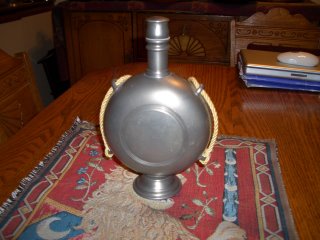This afternoon, Melisande and I visited the
Flint Institute of Arts, which was recently remodeled. We had been planning to see "To Be, Or Not To Be: Four Hundred Years of Vanitas Painting", an exhibit which ends on April 2. There is almost no medieval content in the exhibit, unfortunately, although some of the painters were born during the Renaissance.
Vanitas painting was developed during the 17th Century.
A vanitas painting is a still life (usually) whose imagery suggests imminent decay and mortality. There is often a watch, or fruit about to spoil. In one memorable painting, a mouse is hiding amid the remains of breakfast, unaware of a cat about to pounce. Many of the paintings in the exhibit are very beautiful, some slightly disturbing.
There was a striking difference between the older paintings, before the turn of the 20th century, and the more recent ones. Even for the more representational paintings, the modern paintings were usually crude, blatant or garish. The older paintings were subtle, and usually more skillfully done, although there was amazing skill in some of the more recent paintings, too. The only piece of three-dimensional modern art was spectacularly childish. Melisande looked at it for a moment and then hurried away to the next piece, covering her mouth and trying not to laugh out loud.
I should add that about three of the more modern paintings were quite exceptional, including two I'd love to have prints for - but they were noticeably of the older style, too.
There is a hardcover book on the exhibition for $25, which we bought (that's a very reasonable price for a catalogue of its kind - they usually top $35 and are usually bound in cardstock.) The text is very well-written, and I noticed that the commentary beside the artwork itself had been written with an unusual degree of skill and wit.
An aside about the FIA. I often grow short-tempered with those who denigrate Flint, which admittedly has its problems. Flint can hardly be compared to Ann Arbor or Grand Rapids on this score, but those who think the city is desolate should go down to the cultural center area between the expressway and
Mott Community College. The FIA is a state of the art building with a fine museum shop selling things I had not seen in similar shops elsewhere, and a Starbucks coffee shop. Art by local and state artists was on sale, or could be rented for modest fees (the fees are remitted for eventual purchasers). That seemed like a terrific idea to me - rent art for the office or home, change it whenever you like. The prices were reasonable, and there were also prints. I saw a print of downtown Flint that I think I will buy, frame and put outside my office at Baker after our current remodeling settles down.
There is an element of the FIA that is of more interest to the SCA. The Institute has a fine collection of Renaissance (and slightly later) furniture and tapestry, among other things, in the Bray Gallery. We didn't seek it out today, as we had other places to go. I saw it years ago and was quite impressed.


